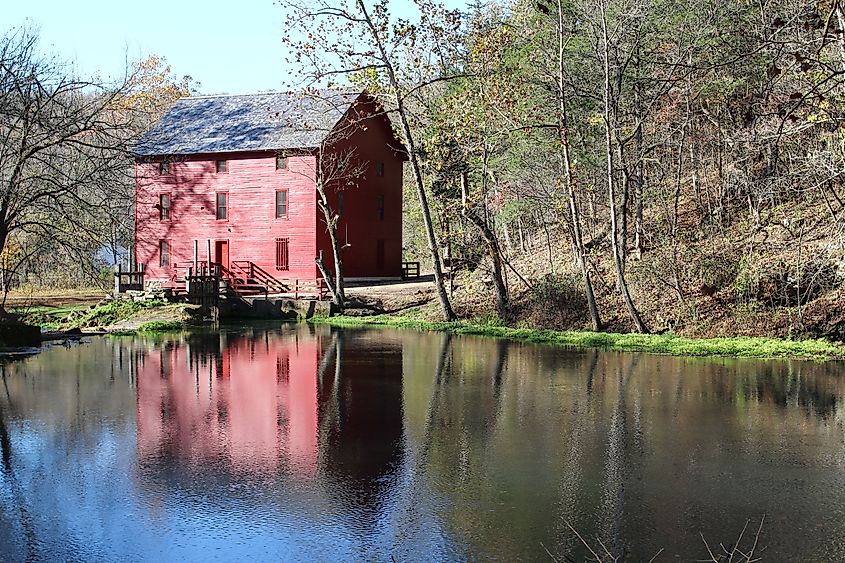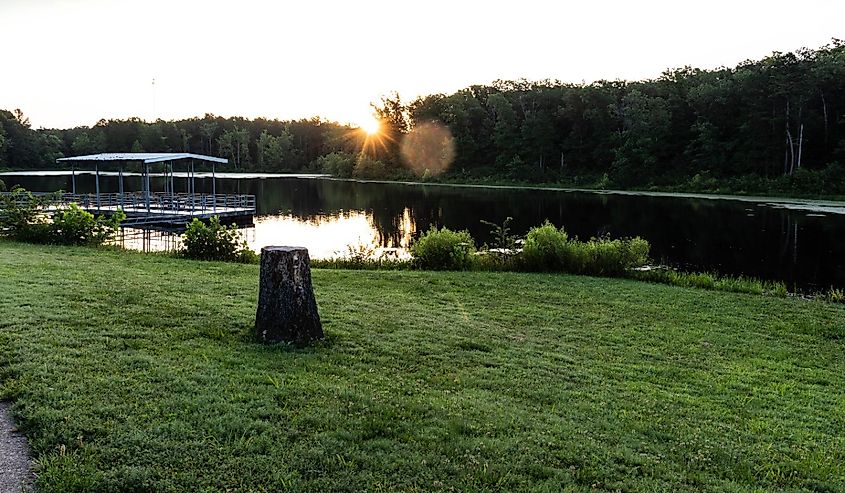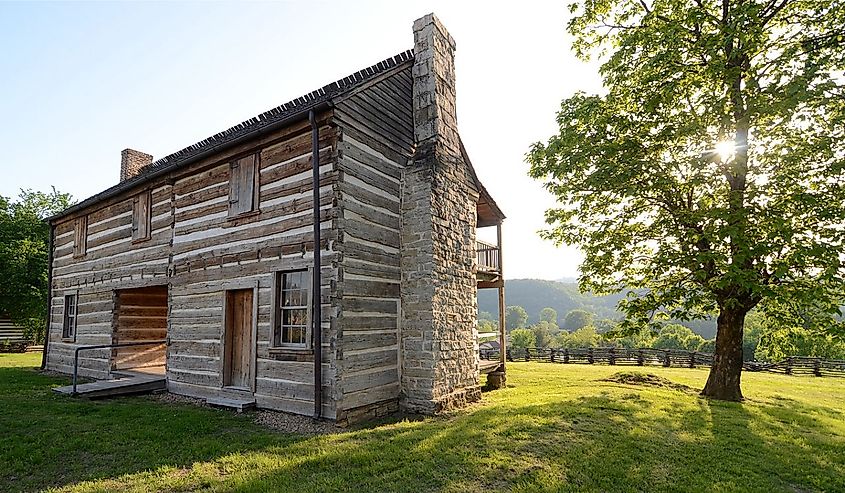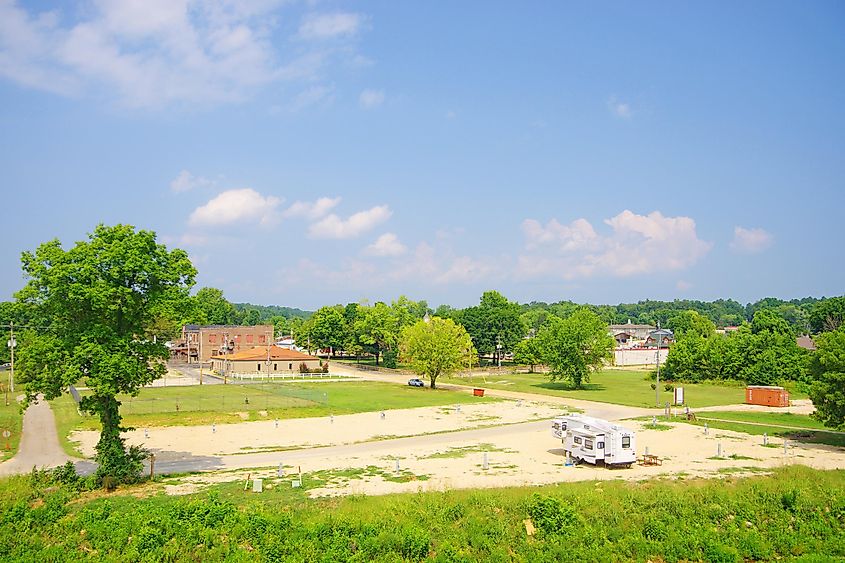COLUMBA − Despite the clouds, people from around Mid-Missouri tried to catch a glimpse of the partial solar eclipse on Saturday.
Any eclipse is rare, according to Teja Teppala, an MU graduate student studying astronomy. Eclipses occur when the moon passes in front of the sun.
Saturday’s eclipse, called an annular eclipse, created a “ring-of-fire” effect visible from New Mexico and the country of Colombia.
But clouds obscured the view in Columbia, Missouri.
“We’re just hoping that the clouds break up and we can actually see something,” said Kevin Cummings.
Cummings and his family went to an eclipse viewing party at MU.
People could try out telescopes and learn about the eclipse from MU physics and astronomy students at Lowry Mall from 10 a.m. to 1:30 p.m.
It was organized by the Department of Physics and Astronomy, MU Extension, and the Division of Inclusion, Diversity and Equity. Teppala was one of the lead organizers.
Teppala said the eclipse would be most visible at noon, when it became a “maximum eclipse.”
The skies above Columbia were still cloudy at noon, so people tuned into NASA’s live stream of the eclipse from New Mexico.
Michelangelo Landgrave, an MU assistant professor of political science and public affairs, brought up the stream on his phone.
“It also looks like a doctor strange, like opening up the portal,” he said.
We’re getting our first views of the “ring of fire”!
Here’s a look at the annular solar eclipse from Albuquerque, N.M., as the Moon nearly (but not completely) covers up the Sun. pic.twitter.com/SCW8r77FG4
— NASA (@NASA) October 14, 2023
Teppala and other organizers are part of an eclipse ambassador program organized by the Astronomical Society of the Pacific, a San Francisco-based nonprofit which seeks to raise interest in astronomy.
The ambassador program partners with NASA to educate people about the eclipse.
One of Teppala’s goals is to combat misinformation. He said the eclipse isn’t harmful, unless you look directly at it.
“I like interacting with people and communicating science with broad audiences,” Teppala said. “So, I thought it would be a fun event, fun thing to put together.”
The eclipse doesn’t just draw in those studying astronomy. Laura Young, a political science student at MU, handed out eclipse viewers at the watch party.
Young said she joined the ambassadors program in February and trained over the summer to educate people on the eclipse.
Success! An email has been sent to with a link to confirm list signup.
Error! There was an error processing your request.
“I really like the idea of getting out into the community and getting involved,” Young said. “Specifically with just telling people how eclipses work and getting them involved in that process.”
Pati Magomedova attended the event with her young daughters, Maya and Milana.
Magomedova said she’s disappointed that her kids didn’t get to see the eclipse, but is excited they got to try out different telescopes.
“We’ve never seen telescopes like that,” Magomedova said. “It was fun, it was really fun to see it.”
“It’s a rare opportunity”
It was hard to see the eclipse outside, but Columbia Public Schools offered a way for people to still watch it.
CPS hosted a watch party at the district’s planetarium, nestled inside Rock Bridge High School. Families could step into the large, circular planetarium and become immersed in an out-of-this-world show.
A 20-minute movie took viewers on a tour of Earth’s solar system from the perspective of visiting aliens. The movie also showed a simulation of the solar eclipse and explained the science behind the ‘ring-of-fire.’
Meaghann Stoelting is the planetarium’s director, and she’s been preparing for the eclipse for a while. Stoelting said she started watching training webinars and bought her eclipse glasses in October 2022.
Normally the planetarium is a field trip destination for students from across Mid-Missouri.
“It’s also important to celebrate fun celestial happenings, like eclipses,” Stoelting said. “It’s a rare opportunity and special when you get to do it with a bunch of people, even if it’s cloudy outside.”
The planetarium also showed NASA’s livestream on a projector and offered eclipse-themed arts and crafts stations for kids.
Dawn and John Lessiack came to the planetarium with their granddaughter, Marley, after trying to see the eclipse outside.
“I thought it was awesome,” Marley said as she worked on an eclipse-themed necklace made out of cardboard and foil, decorated with a space ship flying past Mars.
The planetarium offers free shows open to the public every month. Stoelting said the next opportunity for the public to visit will be Saturday, Nov. 11, with shows at 10 a.m., 11 a.m. and noon.
You can find the full schedule on the planetarium’s website.
Both Stoelting and Teppala said they are looking forward the near-total eclipse which should be visible in Columbia on April 8. Teppala said a total eclipse will likely be visible in southeastern Missouri.
“Even though it’s cloudy, it’s really fun to see an eclipse,” Stoelting said.

 White River and Ozark National Forest in Calico Rock, Arkansas. Image credit Bonita R. Cheshier via Shutterstock
White River and Ozark National Forest in Calico Rock, Arkansas. Image credit Bonita R. Cheshier via Shutterstock Alley Spring and Mill in Eminence, Missouri. Image credit Ian Peter Morton via Shutterstock.com
Alley Spring and Mill in Eminence, Missouri. Image credit Ian Peter Morton via Shutterstock.com Quaint-covered bridge over a cascading waterfall in autumn in Ponca, Arkansas. Image credit Bonnie Taylor Barry via Shutterstock
Quaint-covered bridge over a cascading waterfall in autumn in Ponca, Arkansas. Image credit Bonnie Taylor Barry via Shutterstock Cliff House Inn, located along Arkansas scenic highway 7 North, near Jasper, Arkansas. Image credit Tammy Chesney via Shutterstock.com
Cliff House Inn, located along Arkansas scenic highway 7 North, near Jasper, Arkansas. Image credit Tammy Chesney via Shutterstock.com Route 66 Welcome Center at Baxter Springs, Kansas. Image credit Vanessa Ezekowitz via Wikimedia Commons
Route 66 Welcome Center at Baxter Springs, Kansas. Image credit Vanessa Ezekowitz via Wikimedia Commons Women sitting by the lake at Grand Lake, Oklahoma. Image credit Vineyard Perspective via Shutterstock
Women sitting by the lake at Grand Lake, Oklahoma. Image credit Vineyard Perspective via Shutterstock Early morning sunrise at Shawnee Mac Lake in Salem, Missouri.
Early morning sunrise at Shawnee Mac Lake in Salem, Missouri. Pocahontas, Arkansas, the Historic Randolph County Courthouse at dusk. Image credit Roberto Galan via Shutterstock
Pocahontas, Arkansas, the Historic Randolph County Courthouse at dusk. Image credit Roberto Galan via Shutterstock The Jacob Wolf House was built in 1829. Image credit Photolitherland via Wikimedia Commons
The Jacob Wolf House was built in 1829. Image credit Photolitherland via Wikimedia Commons Van Buren across a campground from US 60; courthouse square in the distance. Image credit Brian Stansberry – Own work, CC BY 4.0, File:Van-Buren-from-US60-mo.jpeg – Wikimedia Commons
Van Buren across a campground from US 60; courthouse square in the distance. Image credit Brian Stansberry – Own work, CC BY 4.0, File:Van-Buren-from-US60-mo.jpeg – Wikimedia Commons





